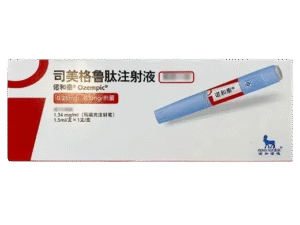No products in the cart.
Semaglutide (Ozempic/Wegovy) 2.5mg 7mg Guide: Uses, Dosage, Side Effects & FAQs
Contents
hide
Introduction
Semaglutide, marketed as Ozempic for type 2 diabetes (T2DM) and Wegovy for chronic weight management, is a glucagon-like peptide-1 (GLP-1) receptor agonist. It mimics the incretin hormone GLP-1, enhancing insulin secretion, suppressing glucagon, slowing gastric emptying, and reducing appetite.
This comprehensive guide provides detailed information about Semaglutide’s pharmacology, clinical trial evidence, dosage recommendations, safety profile, patient selection, and frequently asked questions. It is intended for educational purposes and should not replace professional medical advice.

1. Pharmacology and Mechanism of Action
Semaglutide is a long-acting GLP-1 receptor agonist. Key mechanisms include:
Glucose-dependent insulin secretion
Stimulates pancreatic beta cells to release insulin in response to elevated glucose.
Glucagon suppression
Reduces hepatic glucose output by suppressing glucagon secretion.
Delayed gastric emptying
Slows nutrient absorption, reducing postprandial glucose spikes.
Appetite regulation and weight reduction
Acts on the hypothalamus to increase satiety and reduce food intake.
Pharmacokinetics
Administered subcutaneously once weekly
Half-life ~165 hours (weekly dosing possible)
Metabolized via proteolytic degradation, minimal renal excretion
2. Clinical Trial Evidence
Type 2 Diabetes (T2DM)
SUSTAIN Trials (SUSTAIN 1–7)
Results:
HbA1c reduction: 1.0–1.8%
Body weight reduction: 2–6 kg
Cardiovascular outcomes (SUSTAIN-6): reduced MACE (major adverse cardiovascular events)
Weight Management
STEP Trials (STEP 1–8)
Results:
Mean weight loss: 10–17% over 68 weeks
Significant improvements in BMI, waist circumference, and metabolic parameters
Safety Overview
Common adverse events: nausea, vomiting, diarrhea, constipation
Rare but serious: pancreatitis, diabetic retinopathy progression, gallbladder events
Overall tolerability is acceptable; gradual dose escalation reduces GI side effects
3. Dosage and Administration
Ozempic (T2DM):
Initiate 0.25 mg weekly for 4 weeks, then increase to 0.5 mg weekly.
Optional escalation to 1 mg weekly if needed.
Wegovy (Weight Management):
Initiate 0.25 mg weekly, escalate every 4 weeks up to 2.4 mg weekly.
Administration Guidelines:
Subcutaneous injection in abdomen, thigh, or upper arm
Rotate injection sites weekly
Do not mix with other GLP-1 RAs
4. Side Effects
Gastrointestinal: nausea, vomiting, diarrhea, constipation
Hypoglycemia (rare when not combined with insulin or sulfonylureas)
Injection site reactions
Pancreatitis (rare, monitor for abdominal pain)
Thyroid C-cell tumors in rodents (human risk not established)
Management Strategies:
Slow dose escalation
Hydration and dietary adjustments
Temporary dose interruption for severe side effects
5. Patient Selection and Contraindications
Ideal Candidates:
T2DM patients needing better glycemic control
Adults with obesity or overweight with weight-related comorbidities
Contraindications:
Personal/family history of medullary thyroid carcinoma
Multiple endocrine neoplasia syndrome type 2
Pregnancy and breastfeeding
Special Populations:
Renal or hepatic impairment: dose adjustments not usually required
Elderly: monitor for dehydration due to GI effects
Children: limited data
6. Real-World Evidence
Patients with T2DM: improved HbA1c and reduced insulin requirements
Obesity patients: substantial, sustained weight loss, improved metabolic markers
Combination therapy with lifestyle modifications enhances results
7. Extended FAQ (15–20 Questions)
Q1: What is Semaglutide used for?
A: T2DM management and chronic weight loss.
Q2: How effective is it for diabetes?
A: Reduces HbA1c by 1–1.8%, improves glycemic control.
Q3: How much weight can I lose?
A: Clinical trials show 10–17% body weight reduction over 68 weeks.
Q4: Can it cause hypoglycemia?
A: Rare unless combined with insulin or sulfonylureas.
Q5: What are common side effects?
A: Nausea, vomiting, diarrhea, constipation, injection site reactions.
Q6: How is it administered?
A: Subcutaneous injection, once weekly.
Q7: Can it be used in children?
A: Limited data; currently approved for adults.
Q8: Is it safe during pregnancy?
A: Contraindicated.
Q9: How long does treatment last?
A: Ongoing therapy; duration depends on goals and tolerance.
Q10: Can I combine with other diabetes medications?
A: Yes, but monitor hypoglycemia risk.
Q11: Does it affect appetite?
A: Yes, reduces hunger and promotes satiety.
Q12: How fast will I see results?
A: Glycemic control within weeks; weight loss over months.
Q13: Are there cardiovascular benefits?
A: Yes, reduced MACE observed in T2DM patients at high CV risk.
Q14: How do I manage GI side effects?
A: Slow dose escalation, hydration, dietary adjustments.
Q15: Are injections painful?
A: Generally mild; rotating injection sites helps.
Q16: Does it interact with other medications?
A: Minimal interactions, except with insulin/sulfonylureas.
Q17: Can I stop if I achieve my goals?
A: Consult your healthcare provider; therapy is often long-term.
Q18: Is weight regain common after discontinuation?
A: Yes, lifestyle management is essential to maintain results.
8. Disclaimer
Educational purposes only. Not a substitute for professional medical advice. Always consult a healthcare provider before starting, adjusting, or stopping Semaglutide.
9. References
GLP-1 receptor agonists

